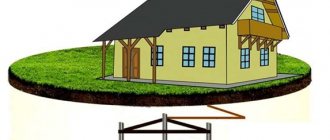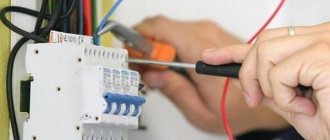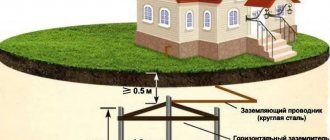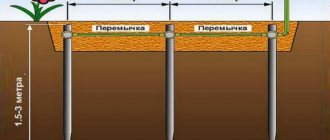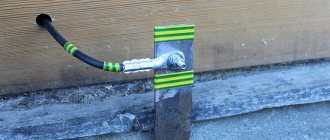Opinions differ about the need to ground a bathtub in an apartment. Some argue that it is not necessary to do it. Others make arguments that support the importance of doing such work. Electricians believe that a protective circuit is still needed. When water supply systems were created from metal pipes, the plumbing was grounded through a riser. This option is not currently used.
Features of bathroom wiring
The bathroom is a room with high humidity, so there are special requirements for wiring here. During work, a triple-braided cable with a grounding conductor is used. Distribution boxes and a large number of switches and sockets cannot be installed in bathrooms. Nowadays, apartments are equipped with powerful electrical appliances, such as boilers or washing machines. In this case, you need to lay wires with a larger cross-section that will not overheat when the equipment is turned on.
Sometimes people feel a slight tingling sensation when taking a bath. This happens when the integrity of the cable braid is damaged. Water is a good conductor of electricity, which is transmitted to humans. Over time, a powerful charge builds up that can kill. The protective circuit removes electricity and prevents the occurrence of traumatic situations.
Wire selection
The town house bathroom uses 6mm stranded cable. This is enough to ensure a high level of electrical safety for people living in the apartment. A similar cable is suitable for heated plumbing. It must be durable, copper. But it is permissible to use a cable made of steel. It usually has a copper shell.
It is better to disguise the cable. Any wire located outside spoils the interior.
General information about grounding
This is the name for a system that removes current from the body of an electrical appliance and takes it to the ground. Most modern devices are equipped with trenches designed for grounding.
Necessity
Water is a good conductor of electricity. This means that when a person visits the bathroom, there is always a danger of electric shock. A large number of steel pipes combined with high humidity increase the likelihood of electrical injuries, so it is important to properly arrange the grounding circuit.
Importance
Remember, water is an unrivaled conductor of electricity, so the bathroom has always been and will remain the most dangerous place in your home.
Do I need to ground the bathtub? - a question that has only one answer - positive. Every plumber will convince you to protect yourself and your family, and it’s not worth taking risks with electric shock.
A grounding loop is a necessary detail in rooms like a bathroom, that is, with high levels of humidity.
Let's take a closer look at why you need to ground the bathtub: for safe use of the bathtub by the whole family, to equalize the electrical power of any current-conducting surfaces. It is very important to consider the grounding effect globally, taking into account other plumbing and household appliances in the bathroom. Otherwise, grounding the bathtub will only be pointless.
The safety of the bathroom will also be determined by the correct installation of all appliances in the room, taking into account the rules and regulations for correct electrical installation.
Features of grounding bathtubs made of different materials
Bowls made of any material require protection against current leakage.
Cast iron
This type of bath requires grounding. Cast iron, like other metals, conducts electricity well. Because of this property, sooner or later a person begins to feel an unpleasant tingling sensation during water procedures. New cast iron baths are equipped with a special part for connecting the ground loop. The petal is secured with a nut and bolt. Further actions are performed according to the standard scheme.
Steel
In this case, the grounding bus is connected in the same way as in a cast iron bath. The petal is already there, so there is no need to drill holes to install it. When tightening the crimp screw, the corresponding area is cleared of enamel. The coating must be removed down to the base - this makes grounding more effective.
Acrylic
Such bathtubs are now often installed. A positive quality of an acrylic bowl is considered to be light weight. However, this property is also a disadvantage. The light bowl is unstable, so it is mounted on a frame. Manufacturers include a metal frame in the kit. If grounding is not required when arranging a wooden frame or concrete pedestal, then it must be done for steel. Acrylic is considered a dielectric, but can accumulate some charge.
The frame is equipped with a jumper for grounding. If it is not there, drill a hole.
The decorative coating is removed in the same way as when working with steel bowls. Paint is considered a dielectric.
How to ground plumbing and why it needs to be done
Modern apartments are in most cases overcrowded with a variety of household appliances and metal products. The bathroom is no exception. In small toilet rooms you can see a large selection of electrical appliances and plumbing items that are potentially dangerous to humans. Even an acrylic bathtub is included in this list, although it is made of dielectric material. This product is capable of accumulating a powerful charge of static electricity, which can cause significant damage to a person. In addition, the acrylic container is installed on a metal frame, and it conducts electricity well.
All this suggests that grounding in the bathroom must be created, although there are no special requirements in regulatory documents in this regard. For a private house or country house, creating a grounding loop in the bathroom will not be difficult, but in apartments of multi-storey buildings you will have to bring out the grounding wire to the floor distribution board and connect it to a special bus. We will consider below how to protect various plumbing items from the appearance of dangerous electric voltage on them and how to ground a bathtub in an apartment.
Important! The grounding conductor has green-yellow insulation and is designated on the wiring diagrams by the letters PE. This is necessary in order not to confuse the grounding cable with the power lines of the facility's power supply.
Grounding old bathtubs
In Soviet times, cast iron or steel were mainly used to make bathtubs. These products did not provide special structural elements that are necessary to connect the ground wire. But this problem can be solved quite simply! To complete the work, you will need the following tools and materials: an electric drill, a drill with a pobedit tip, a jumper for connecting the ground wire, a set of fasteners (bolt, washers and nuts), as well as a stranded copper cable and a distributor of all ground taps.
A hole of the required diameter is drilled in the bathtub leg and a grounding jumper is installed on the threaded connection. A grounding conductor is attached to the jumper and brought out to the switchgear. The device itself must be secured in a convenient place, since all grounding wires from metal products located in the bathroom will be connected to it. From the distributor, the common grounding wire must be led to the distribution board on the floor landing and connected to the protective grounding bus. All this work is quite simple and can be done with your own hands.
Grounding modern cast iron and steel bathtubs
Grounding cast iron bathtubs manufactured in the last decade will not cause problems even for an inexperienced consumer. All of them are equipped with special petals with a mounting kit for connecting the grounding conductor. Simply tighten the bare end of the wire between the washers and bring it out to the distributor. If for some reason the jumper is missing, a hole will need to be drilled. It is best to perform this operation on special thickenings of the bathtub body, which are designed to wedge the load-bearing legs of the product. This option will create reliable contact between the ground wire and the bathtub.
There will be no special problems with steel bathtubs either. They usually have a petal and do not need to drill a hole. It is enough to strip the enamel coating around the hole on the petal down to the metal and use a crimp screw to secure the grounding conductor. All other operations must be performed by analogy with cast iron baths. Next, we will consider the question of whether it is necessary to ground an acrylic bathtub and how to do this work correctly.
Attention! It is prohibited to connect the ground to the removable legs of steel and cast iron bathtubs. This is due to the fact that there is no normal electrical contact between the supporting elements and the bathtub itself!
Grounding acrylic bathtubs
Acrylic bathtubs are becoming very popular sanitary products. It is they who are gradually ousting steel and cast iron products from the market. The main advantage of acrylic bathtubs is their light weight, but at the same time this is a definite disadvantage. There are two types of such products: cast and extruded. The second type of acrylic plumbing products is installed on steel frames, and as we know, metal is an excellent conductor of electricity. Therefore, acrylic bathtub frames must be grounded. Grounding an acrylic bathtub is carried out by analogy with steel products.
Important! Water getting between the body of an acrylic bathtub and the supporting metal frame can lead to the formation of a conductive layer, so this structure must be grounded!
Jacuzzi grounding
If we can argue about the need to ground various models of bathtubs, then for Jacuzzis (hydromassage baths) this procedure is mandatory! This plumbing product is a complex household appliance that consumes electricity, and any electrical appliance in the bathroom must have protection against the appearance of mains voltage on its body. Hydromassage baths are connected to the grounding bus through special sockets designed for installation in rooms with high humidity. They have special curtains in their design that protect the contacts from water getting on them.
Sockets for connecting a jacuzzi are installed at a distance of 30 cm from the floor of the bathroom and 50 cm from the edge of the whirlpool bath. The cable for supplying electricity and the grounding conductor must be double insulated and placed in a corrugated pipe. For a Jacuzzi, a separate RCD and circuit breaker must be installed in the switchboard; in addition to grounding, this will ensure reliable protection of a person from electric shock. The PUE rules prohibit grounding hydromassage baths through the water supply system. It is advisable to involve an experienced electrician in the installation of a jacuzzi, as this will allow you to avoid errors when connecting.
Attention! When installing electrical wiring and protective grounding cables, the use of twists and other unreliable connections that can lead to a broken contact and electric shock to a person is not allowed!
Grounding the heated towel rail
How to ground a stainless steel heated towel rail and is it necessary? The answer to this question can be found in physics textbooks and reference books! There are such concepts as galvanic corrosion and stray currents. These two unpleasant phenomena can reduce the life of the heated towel rail to a minimum! Stray currents occur when electrical energy leaks into the heating system from damaged wiring, household appliances, and for some other reasons. Galvanic corrosion occurs when two dissimilar metals interact with water, which is to some extent an electrolyte.
These two factors can damage a stainless steel heated towel rail, so it should be grounded. Heating systems consisting of metal pipes are initially grounded and additional grounding is not required to equalize potentials on the heated towel rail. But if the heating pipes are plastic, then it is better to connect it to a common ground bus on the distribution board. This operation will not cause any difficulties; it is enough to secure the grounding conductor to the heated towel rail using a metal clamp and remove its zero bus.
Grounding an old-style bathtub
Such plumbing fixtures do not have a special petal.
To connect the grounding loop, prepare materials and devices:
- drill;
- metal drill;
- grounding petal;
- fasteners: nut, screw, washer;
- thick cable.
Holes are drilled in the bathtub frame to attach the grounding tab. The jumper is secured with a screw, washer and nut. A wire is connected to the petal, which is connected to the distributor. The latter is fixed on the wall. The distributor is connected to the switchboard through the grounding bus.
Cables from all metal elements located in the bathroom are connected to the same box.
Contour on plastic utilities
Previously, the role of the ground electrode (circuit) was played by water pipes (metal), since they are connected by welding to the riser. The latter goes down to the basement and disappears there under the ground.
Today, in the context of replacing metal pipes with plastic analogues that do not conduct current, it is necessary to lay a cable (from one core) of large cross-section into the bathroom. It will play the role of a grounding conductor (or circuit).
Grounding the heated towel rail
Stray charges and galvanic oxidation reduce the service life of the product. The first factor arises due to damage to wiring and household appliances. Galvanic corrosion is promoted by the interaction of water and dissimilar metals. Because of this, grounding the heated towel rail is considered mandatory.
When the heating system consists of metal pipes and is protected from the beginning, there is no need to equalize the potentials.
If the elements are plastic, they must be connected to a common bus. The procedure is not difficult; it is enough to attach the conductor to the heated towel rail with a clamp and connect it to the zero bus.
Theory
Many electronic household appliances these days have small metal grooves designed for grounding.
This term refers to a special protection that takes electric current when it appears on the body of an object and leads it to the ground. Everyone in their life has experienced mild electric shocks when touching electrical appliances. Quite often this can happen if you touch a computer, washing machine or heating tank. In the latter case, this occurs due to the formation of a hole in the heating element, which causes electricity to pass through the water.
Often this happens because the electrical wiring in our homes was not installed properly. If there are grounding devices, this problem will not cause inconvenience.
Step-by-step instructions for grounding a bathtub with your own hands
If there is no protective circuit in the apartment, work can be difficult. However, this situation can be corrected.
Selection of materials
First, determine what you need to buy. First of all, you need to select a cable of the appropriate cross-section. A good option is a 6 sq. ready-made wire. mm in green-yellow braid.
In addition to this, you need to purchase:
- potential equalization box;
- RCD of suitable rating;
- clamps;
- terminals.
The equalization box is a plastic compartment in which all branches of the grounding bus converge. The RCD is located outside the bathroom. Its rating should be 10 or 16 A. However, when installing powerful household appliances, this value may not be enough. Terminals are products that help firmly fix the cable to the grounding tab. Clamps are used when it is necessary to connect conductors to pipes.
Preparing tools for electrical work
To install a protective circuit, you will need a standard set of devices, including:
- screwdriver;
- spanners;
- flashlight;
- universal tester;
- welder;
- drill.
A screwdriver for working with electrical cables must be indicator. Its handle is equipped with a light that is activated when the wire is energized. The wrench is used when connecting the ground bar to the spade. A drill will be needed if there are no technological holes. A multimeter is used to determine the voltage in the network. The welding machine is used when bringing the circuit outside.
Tire gasket
Some houses are equipped with a common grounding bus. However, developers do not always care about the safety of residents. If there is a circuit, all appliances installed in the bathroom are grounded through the electrical panel on the staircase.
Compliance with safety regulations
When grounding devices in a bathroom, the following rules apply:
- The work must be comprehensive. All appliances and plumbing fixtures in the bathroom must be grounded, otherwise the circuit will not function effectively enough.
- For grounding, you need to use a copper conductor with a cross-section of 6 square meters. mm. This way the circuit removes the maximum amount of current.
- A special structure needs to be assembled near the house. Simply inserting the fittings into the ground is not enough - this way, not all the current will be drained from the bathtub.
- Additionally, it is recommended to install an RCD. The device turns off the current when a person interacts with exposed wires. This device performs its task without grounding.
If these rules are followed, the circuit will function smoothly.

